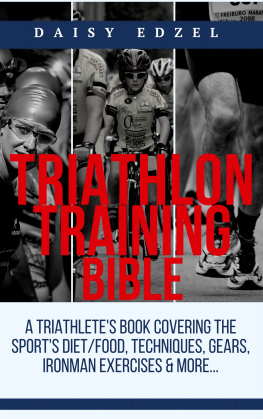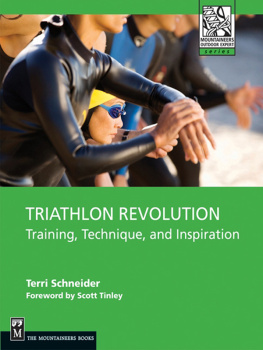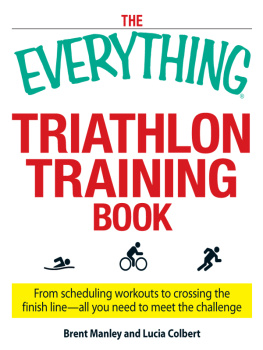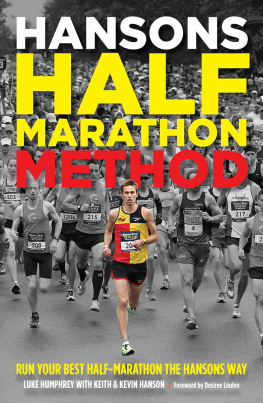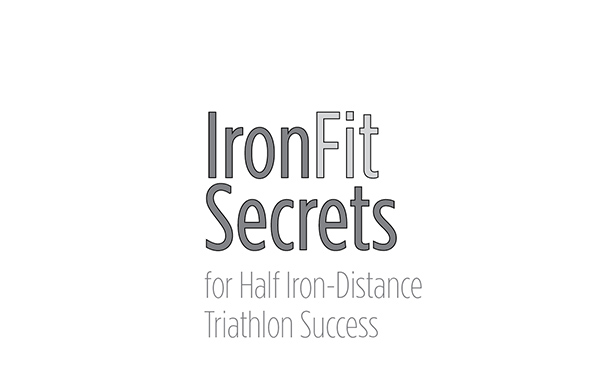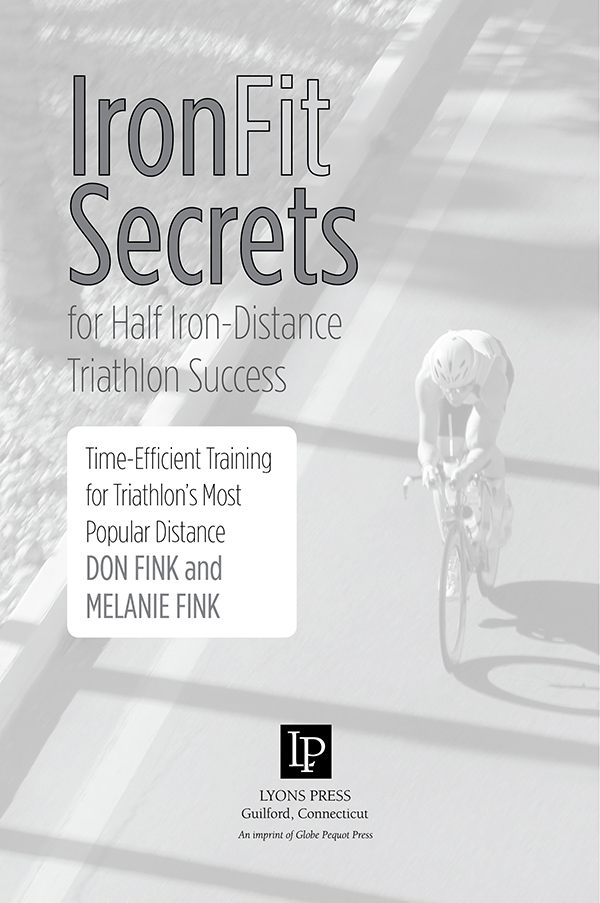Also by Don Fink and Melanie Fink:
Be Iron Fit, Second Edition
Mastering the Marathon
IronFit Strength Training and Nutrition for Endurance Athletes
Copyright 2014 by Don Fink and Melanie Fink
ALL RIGHTS RESERVED. No part of this book may be reproduced or transmitted in any form by any means, electronic or mechanical, including photocopying and recording, or by any information storage and retrieval system, except as may be expressly permitted in writing from the publisher. Requests for permission should be addressed to Globe Pequot Press, Attn: Rights and Permissions Department, P.O. Box 480, Guilford, CT 06437.
Lyons Press is an imprint of Globe Pequot Press
Ironman, Ironman Triathlon, and Ironman 70.3 are registered trademarks of the World Triathlon Corporation
IronFit is a registered trademark of Don Fink
All exercise photos featuring Yvonne Hernandez are provided courtesy of Lynn Kellogg/www.trilifephotos.com.
Cover photograph: Jessi Stensland (www.gojessi.com) by Action Sports International
Illustrations by Tom Debiasse
Text design/layout: Mary Ballachino
Project editor: Ellen Urban
Library of Congress Cataloging-in-Publication Data is available on file.
ISBN 978-1-4930-0418-8
MEDICAL DISCLAIMER
The programs in this book are designed for athletes with either a high level of fitness or the physiology to attain a high level of fitness. Readers should consult a physician before beginning any of the workouts suggested herein. If you experience any pain or difficulty with these exercises, stop and consult your health-care provider.
To our loving parents, Esther and Martin and Claire and Richard
Contents
Introduction
The Half Iron-Distance has grown to become triathlons most popular race. Over half a million athletes will race this distance worldwide in the coming year, and the number of races continues to grow at an amazing rate.
The Half Iron-Distance Triathlon includes a 1.2-mile open-water swim, followed by a 56-mile bike ride and a 13.1-mile run. (The metric equivalents of these distances are a 1.9 km swim, a 90 km bike, and a 21.1 km run.) These distances are exactly half those of the full Iron-Distance. Many around the world also refer to the Half Iron-Distance as Middle Distance and Long Course, but most triathletes simply refer to it as the Half.
At the time Be Iron Fit was written eight years ago, only a handful of races existed at the Half Iron-Distance level. These were considered more of a stepping stone on the way to the Iron-Distance dream, little more than a tune-up or dress rehearsal for the full Iron-Distance. Today that has all changed in the triathlon world.
The Half Iron-Distance being the most popular triathlon, the number of races has skyrocketed and continues to grow with no end in sight. There are now several major race series spanning the globe featuring this triathlon distance, and there are also hundreds and hundreds of additional independent races worldwide. The estimated over half a million athletes who will race the Half in the coming year will possibly be more than twice the number who will race the full Iron-Distance.
Why has the Half Iron-Distance grown to become triathlons most popular distance? Its because it is the perfect distance for the vast majority of busy athletes who also have demanding career and family responsibilities. While the full Iron-Distance is doable, it takes very careful planning and a lot of sacrifice to accomplish the goal while also keeping the rest of life in balance. In contrast, the Halfstill a very substantial and challenging distanceprovides a much more accessible opportunity to compete at a high level while also maintaining a positive and sustainable lifestyle balance.
Despite the Half Iron-Distances soaring popularity, a general misunderstanding exists regarding how best to prepare for it. Because the word Iron is often part of the races title, many athletes assume that you prepare for it just like the full Iron-Distance Triathlon. We have even had athletes over the years ask us if they should just take one of the training programs in Be Iron Fit and do half of it.
This assumption is not correct, as you prepare quite differently for these two races. Cutting the training in half would in no way approach the goal of maximizing your performance. These races are competed at different intensity levels, with different approaches, and, as a result, the training is different as well.
IronFit Secrets for Half Iron-Distance Triathlon Success provides a clear path to maximizing an athletes success at this popular racing distance. If you want to optimize your Half Iron-Distance performance, you have come to the right place. Its all right here. This book contains the training programs and the information you need to achieve your Half Iron-Distance dream.
You can benefit most from this book if you already have a basic level of triathlon knowledge. Perhaps you have participated in shorter-distance triathlons, road racing, cycling, or open-water swim competitions. Or perhaps you have already completed a Half Iron-Distance Triathlon, and you want to train smarter and race faster. We will take you through everything you need to do to accomplish your Half Iron-Distance goal.
As with all of our books, IronFit Secrets for Half Iron-Distance Triathlon Success is not written with a lot of technical talk and scientific lingo; instead, we present information in a clear and useful way, spelling out exactly what you need to do, and when you need to do it. No complicated formulas, no guessworkjust a clear, step-by-step path to achieving your goal. We provide you with effective training, efficient time management, and been there, done that knowledge.
We start with a presentation of the eight essential training sessions and how they fit into the proper training cycles for the Half. From there, we discuss the crucial training principles for this race, including how to make heart rate training work for you. Its important to take full advantage of the essential workouts, how they should be arranged in proper training cycles, and how they are influenced by the crucial training principles, for athletes to optimize their training results. And, essentially, to avoid what we refer to as junk training.
With an understanding of these topics, we then present three detailed sixteen-week Half Iron-Distance training programs. These programs are designed to be user-friendly, and can be put to immediate use. Guidance is also provided to help you select the program that best fits your goals, experience level, and available training time.
While the sixteen-week programs cover all of the specific training sessions in swimming, cycling, and running, this book also provides a highly effective warm-up routine, a functional strength and core training program, and a stretching and flexibility routine, all specifically designed for success in the Half. We also present specific training and guidance on the Half Iron-Distances fourth sport, the two transitions known as T1 and T2, often overlooked even though they are key aspects of the race.
From there we cover proper technique in the three sports, and provide tools for improving and fine-tuning your form. Next, we discuss the necessary equipment for Half Iron-Distance success, including suggestions on the most economical ways to buy speed.


